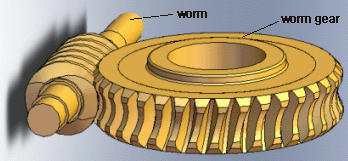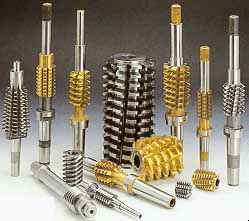|
1. Worm과 Worm Gear
A worm drive is a gear arrangement in which a worm (which is a gear in the form of a screw) meshes with
a worm gear (which is similar in appearance to a spur gear, and is also called a worm wheel).
A worm is used to reduce speed. For each complete turn of the worm shaft the gear shaft advances only
one tooth of the gear.
Unlike ordinary gears, the motion is not reversible, a worm can drive a gear to reduce speed but a gear
cannot drive a worm to increase it.
As the speed is reduced the power to the drive increases correspondingly. Worm gears are a compact,
efficient means of substantially decreasing speed and increasing power. Ideal for use with small
electric motors.
|
|
2. Worm Gear 가공
A hobbing machine is a special form of milling machine that cuts gears. It is the major industrial
process for cutting (as opposed to grinding) spur gears of involute form.
The machine forms the gear via a generating process by rotating the gear blank and the cutter (called a
hob) at the same time with a fixed gearing ratio between hob and blank. The hob has a profile given in
cross-section by the fundamental rack for the gear tooth profile and is in the form of a helix so that
the sides of the teeth on the hob generate the curve on the gear. The helix has a number of cuts parallel
to the axis to form the cutting teeth and the profile is suitably relieved to provide cutting clearance.
For a tooth profile which is a theoretical involute, the fundamental rack is straight-sided, with sides
inclined at the pressure angle of the tooth form, with flat top and bottom. The necessary addendum
correction to allow the use of small-numbered pinions can either be obtained by suitable modification
of this rack to a cycloidal form at the tips, or by hobbing at other than the theoretical pitch circle
diameter. Since the gear ratio between hob and blank is fixed, the resulting gear will have the correct
pitch on the pitch circle, but the tooth thickness will not be equal to the space width.
Hobbing is invariably used to produce throated worm wheels, but it is not possible to cut all useful
tooth profiles in this way; if any portion of the hob profile is perpendicular to the axis then it
will have no cutting clearance generated by the usual backing off process, and it will not cut well.
The NHS Swiss tooth standards give rise to such problems. Such small gears normally must be milled
instead.
This technique can generate involute gears, ratchets and cycloid gears.
|



